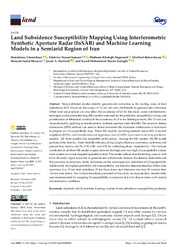Land subsidence susceptibility mapping using interferometric synthetic aperture radar (InSAR) and machine learning models in a semiarid region of iran
| dc.contributor.author | Gharechaee, H. | |
| dc.contributor.author | Samani, A. N. | |
| dc.contributor.author | Sigaroodi, S. K. | |
| dc.contributor.author | Baloochiyan, Abolfazl | |
| dc.contributor.author | Moosavi, M. S. | |
| dc.contributor.author | Hubbart, J. A. | |
| dc.contributor.author | Sadeghi, S. M. M. | |
| dc.date.accessioned | 2023-11-01T10:27:46Z | |
| dc.date.available | 2023-11-01T10:27:46Z | |
| dc.date.issued | 2023-04 | |
| dc.identifier.issn | 2073-445X | en_US |
| dc.identifier.uri | http://hdl.handle.net/10679/8913 | |
| dc.identifier.uri | https://www.mdpi.com/2073-445X/12/4/843 | |
| dc.description.abstract | Most published studies identify groundwater extraction as the leading cause of land subsidence (LS). However, the causes of LS are not only attributable to groundwater extraction. Other land-use practices can also affect the occurrence of LS. In this study, radar interferometric techniques and machine learning (ML) models were used for the prediction, susceptibility zoning, and prioritization of influential variables in the occurrence of LS in the Bakhtegan basin. The LS rate was characterized by applying an interferometric synthetic aperture radar (InSAR). The recursive feature elimination (RFE) method was used to detect and select the dominant combination of indicators to prepare an LS susceptibility map. Three ML models, including random forest (RF), k-nearest neighbors (KNN), and classification and regression trees (CART), were used to develop predictive models. All three models had acceptable performance. Among the ML models, the RF model performed the best (i.e., Nash–Sutcliffe efficiency, Kling–Gupta efficiency, correlation coefficient, and percent bias metrics of 0.76, 0.78, 0.88, and 0.70 for validating phase, respectively). The analysis conducted on all three ML model outputs showed that high and very high LS susceptibility classes were located on or near irrigated agricultural land. The results indicate that the leading cause of land LS in the study region is not due to groundwater withdrawals. Instead, the distance from dams and the proximity to anticlines, faults, and mines are the most important identifiers of LS susceptibility. Additionally, the highest probability of LS susceptibility was found at distances less than 18 km from synclines, 6 to 13 km from anticlines, 23 km from dams, and distances less than 20 to more than 144 km from mines. The validated methods presented in this study are reproducible, transferrable, and recommended for mapping LS susceptibility in semiarid and arid climate zones with similar environmental conditions. | en_US |
| dc.language.iso | eng | en_US |
| dc.publisher | MDPI | en_US |
| dc.relation.ispartof | Land | |
| dc.rights | openAccess | |
| dc.rights | Attribution 4.0 International | |
| dc.rights.uri | https://creativecommons.org/licenses/by/4.0/ | |
| dc.title | Land subsidence susceptibility mapping using interferometric synthetic aperture radar (InSAR) and machine learning models in a semiarid region of iran | en_US |
| dc.type | Article | en_US |
| dc.description.version | Publisher version | en_US |
| dc.peerreviewed | yes | en_US |
| dc.publicationstatus | Published | en_US |
| dc.contributor.department | Özyeğin University | |
| dc.identifier.volume | 12 | en_US |
| dc.identifier.issue | 4 | en_US |
| dc.identifier.wos | WOS:000977358100001 | |
| dc.identifier.doi | 10.3390/land12040843 | en_US |
| dc.subject.keywords | Drylands | en_US |
| dc.subject.keywords | InSAR | en_US |
| dc.subject.keywords | Machine learning | en_US |
| dc.subject.keywords | Random forest | en_US |
| dc.subject.keywords | Subsidence | en_US |
| dc.subject.keywords | Susceptibility prediction | en_US |
| dc.identifier.scopus | SCOPUS:2-s2.0-85154072704 | |
| dc.contributor.ozugradstudent | Baloochiyan, Abolfazl | |
| dc.relation.publicationcategory | Article - International Refereed Journal - Institutional Graduate Student |
Files in this item
This item appears in the following Collection(s)
Share this page




